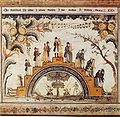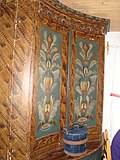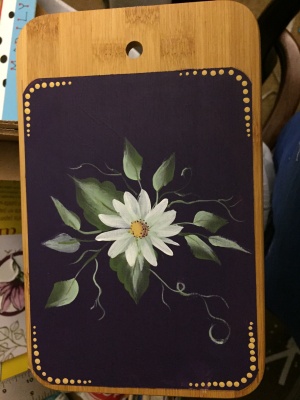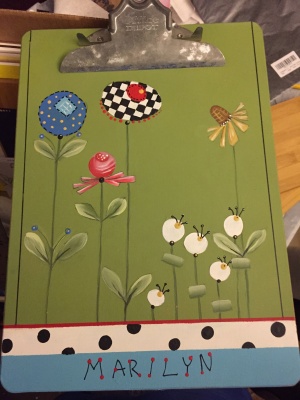Difference between revisions of "AY Honors/Tole Painting/Answer Key"
Jomegat bot (talk | contribs) m (Jomegat bot moved page AY Honor Tole Painting to AY Honor Tole Painting Answer Key: Bot: Moved page) |
Jomegat bot (talk | contribs) (Bot: Automated import of articles *** existing text overwritten ***) |
||
| Line 12: | Line 12: | ||
}} | }} | ||
| − | ==1. What is tole painting? | + | |
| + | <noinclude></translate></noinclude> | ||
| + | <section begin="Body" /> | ||
| + | {{ansreq|page={{#titleparts:{{PAGENAME}}|2|1}}|num=1}} | ||
| + | <noinclude><translate></noinclude> | ||
| + | <!-- 1. What is tole painting? --> | ||
The word tole means "painted enameled or lacquered tinplate used to make decorative domestic objects." Today it is used as a category of folk art and decorative painting, typically on metal or wood used for household items such as utensils chairs, chests, toy boxes, tables, etc. | The word tole means "painted enameled or lacquered tinplate used to make decorative domestic objects." Today it is used as a category of folk art and decorative painting, typically on metal or wood used for household items such as utensils chairs, chests, toy boxes, tables, etc. | ||
| − | ==2. Explain the difference between decorative art and fine art. | + | <noinclude></translate></noinclude> |
| + | {{CloseReq}} <!-- 1 --> | ||
| + | {{ansreq|page={{#titleparts:{{PAGENAME}}|2|1}}|num=2}} | ||
| + | <noinclude><translate></noinclude> | ||
| + | <!-- 2. Explain the difference between decorative art and fine art. --> | ||
In the strictest sense, Fine Art is considered a visual object with no functional purpose except to be admired and contemplated as an aesthetic object. Decorative Art, however, is also visual and aesthetically pleasing but serves a useful function such as a piece of furniture, tableware, textiles and so on. | In the strictest sense, Fine Art is considered a visual object with no functional purpose except to be admired and contemplated as an aesthetic object. Decorative Art, however, is also visual and aesthetically pleasing but serves a useful function such as a piece of furniture, tableware, textiles and so on. | ||
| − | ==3. Name the types of surfaces tole painting is found on. | + | <noinclude></translate></noinclude> |
| + | {{CloseReq}} <!-- 2 --> | ||
| + | {{ansreq|page={{#titleparts:{{PAGENAME}}|2|1}}|num=3}} | ||
| + | <noinclude><translate></noinclude> | ||
| + | <!-- 3. Name the types of surfaces tole painting is found on. --> | ||
Wood, metal, glass, walls, any surface which will hold paint. | Wood, metal, glass, walls, any surface which will hold paint. | ||
| − | ==4. Name three European countries which have tole painting heritage. List what it is called in those countries. | + | <noinclude></translate></noinclude> |
| + | {{CloseReq}} <!-- 3 --> | ||
| + | {{ansreq|page={{#titleparts:{{PAGENAME}}|2|1}}|num=4}} | ||
| + | <noinclude><translate></noinclude> | ||
| + | <!-- 4. Name three European countries which have tole painting heritage. List what it is called in those countries. --> | ||
Norway - Rosemaling | Norway - Rosemaling | ||
| Line 42: | Line 59: | ||
Switzerland – Bauernmalerei | Switzerland – Bauernmalerei | ||
| − | ==5. Identify what types of objects are usually tole painted. | + | <noinclude></translate></noinclude> |
| + | {{CloseReq}} <!-- 4 --> | ||
| + | {{ansreq|page={{#titleparts:{{PAGENAME}}|2|1}}|num=5}} | ||
| + | <noinclude><translate></noinclude> | ||
| + | <!-- 5. Identify what types of objects are usually tole painted. --> | ||
Furniture and tools. | Furniture and tools. | ||
| − | ==6. Find five pictures of tole painted objects, one in each of the listed categories: | + | <noinclude></translate></noinclude> |
| + | {{CloseReq}} <!-- 5 --> | ||
| + | {{ansreq|page={{#titleparts:{{PAGENAME}}|2|1}}|num=6}} | ||
| + | <noinclude><translate></noinclude> | ||
| + | <!-- 6. Find five pictures of tole painted objects, one in each of the listed categories: --> | ||
| − | == | + | <noinclude></translate></noinclude> |
| + | {{ansreq|page={{#titleparts:{{PAGENAME}}|2|1}}|num=6a}} <!--T:14--> | ||
| + | <noinclude><translate></noinclude> | ||
<!--T:29--> | <!--T:29--> | ||
| Line 58: | Line 85: | ||
</gallery> | </gallery> | ||
| − | == | + | <noinclude></translate></noinclude> |
| + | {{CloseReq}} <!-- 6a --> | ||
| + | {{ansreq|page={{#titleparts:{{PAGENAME}}|2|1}}|num=6b}} <!--T:15--> | ||
| + | <noinclude><translate></noinclude> | ||
<!--T:30--> | <!--T:30--> | ||
| Line 69: | Line 99: | ||
</gallery> | </gallery> | ||
| − | == | + | <noinclude></translate></noinclude> |
| + | {{CloseReq}} <!-- 6b --> | ||
| + | {{ansreq|page={{#titleparts:{{PAGENAME}}|2|1}}|num=6c}} <!--T:16--> | ||
| + | <noinclude><translate></noinclude> | ||
<!--T:31--> | <!--T:31--> | ||
| Line 76: | Line 109: | ||
</gallery> | </gallery> | ||
| − | == | + | <noinclude></translate></noinclude> |
| + | {{CloseReq}} <!-- 6c --> | ||
| + | {{ansreq|page={{#titleparts:{{PAGENAME}}|2|1}}|num=6d}} <!--T:17--> | ||
| + | <noinclude><translate></noinclude> | ||
| − | == | + | <noinclude></translate></noinclude> |
| + | {{CloseReq}} <!-- 6d --> | ||
| + | {{ansreq|page={{#titleparts:{{PAGENAME}}|2|1}}|num=6e}} <!--T:18--> | ||
| + | <noinclude><translate></noinclude> | ||
<!--T:32--> | <!--T:32--> | ||
| Line 85: | Line 124: | ||
</gallery> | </gallery> | ||
| − | ==7. What types of paint are used in tole painting? | + | <noinclude></translate></noinclude> |
| + | {{CloseReq}} <!-- 6e --> | ||
| + | {{CloseReq}} <!-- 6 --> | ||
| + | {{ansreq|page={{#titleparts:{{PAGENAME}}|2|1}}|num=7}} | ||
| + | <noinclude><translate></noinclude> | ||
| + | <!-- 7. What types of paint are used in tole painting? --> | ||
The paint appropriate for the surface to be painted and for how the item is to be used. | The paint appropriate for the surface to be painted and for how the item is to be used. | ||
| − | ==8. Make a sample sheet/board of basic decorative painting strokes. Include Comma Stroke (right and left), Tear Drop (Slider Leaf Stroke), U Stroke (C Stroke), Flat Stroke and S Stroke. At least two of the strokes should use two paints side loaded on the brush. | + | <noinclude></translate></noinclude> |
| + | {{CloseReq}} <!-- 7 --> | ||
| + | {{ansreq|page={{#titleparts:{{PAGENAME}}|2|1}}|num=8}} | ||
| + | <noinclude><translate></noinclude> | ||
| + | <!-- 8. Make a sample sheet/board of basic decorative painting strokes. Include Comma Stroke (right and left), Tear Drop (Slider Leaf Stroke), U Stroke (C Stroke), Flat Stroke and S Stroke. At least two of the strokes should use two paints side loaded on the brush. --> | ||
It is best to practice with a flat and a round brush. For the flat a ½ inch or larger is better for practice. Make up a practice sheet for each Pathfinder. | It is best to practice with a flat and a round brush. For the flat a ½ inch or larger is better for practice. Make up a practice sheet for each Pathfinder. | ||
| − | ==9. Make two of the following, using one or more of the basic decorative painting strokes (including preparing the surface and the final finish): | + | <noinclude></translate></noinclude> |
| + | {{CloseReq}} <!-- 8 --> | ||
| + | {{ansreq|page={{#titleparts:{{PAGENAME}}|2|1}}|num=9}} | ||
| + | <noinclude><translate></noinclude> | ||
| + | <!-- 9. Make two of the following, using one or more of the basic decorative painting strokes (including preparing the surface and the final finish): --> | ||
| − | == | + | <noinclude></translate></noinclude> |
| + | {{ansreq|page={{#titleparts:{{PAGENAME}}|2|1}}|num=9a}} <!--T:22--> | ||
| + | <noinclude><translate></noinclude> | ||
[[File:Tole painted cutting board 1197.jpg|thumb|300px|left|Cutting board]] | [[File:Tole painted cutting board 1197.jpg|thumb|300px|left|Cutting board]] | ||
{{clear}} | {{clear}} | ||
| − | == | + | <noinclude></translate></noinclude> |
| + | {{CloseReq}} <!-- 9a --> | ||
| + | {{ansreq|page={{#titleparts:{{PAGENAME}}|2|1}}|num=9b}} <!--T:23--> | ||
| + | <noinclude><translate></noinclude> | ||
| − | == | + | <noinclude></translate></noinclude> |
| + | {{CloseReq}} <!-- 9b --> | ||
| + | {{ansreq|page={{#titleparts:{{PAGENAME}}|2|1}}|num=9c}} <!--T:24--> | ||
| + | <noinclude><translate></noinclude> | ||
| − | == | + | <noinclude></translate></noinclude> |
| + | {{CloseReq}} <!-- 9c --> | ||
| + | {{ansreq|page={{#titleparts:{{PAGENAME}}|2|1}}|num=9d}} <!--T:25--> | ||
| + | <noinclude><translate></noinclude> | ||
| − | == | + | <noinclude></translate></noinclude> |
| + | {{CloseReq}} <!-- 9d --> | ||
| + | {{ansreq|page={{#titleparts:{{PAGENAME}}|2|1}}|num=9e}} <!--T:26--> | ||
| + | <noinclude><translate></noinclude> | ||
[[File:Tole painted clipboard 1196.jpg|thumb|300px|left|Clipboard]] | [[File:Tole painted clipboard 1196.jpg|thumb|300px|left|Clipboard]] | ||
{{clear}} | {{clear}} | ||
| + | <noinclude></translate></noinclude> | ||
| + | {{CloseReq}} <!-- 9e --> | ||
| + | {{CloseReq}} <!-- 9 --> | ||
| + | <noinclude><translate></noinclude> | ||
==References== <!--T:27--> | ==References== <!--T:27--> | ||
| Line 112: | Line 182: | ||
[[Category:Adventist Youth Honors Answer Book|{{SUBPAGENAME}}]] | [[Category:Adventist Youth Honors Answer Book|{{SUBPAGENAME}}]] | ||
<noinclude></translate></noinclude> | <noinclude></translate></noinclude> | ||
| + | <section end="Body" /> | ||
Revision as of 20:23, 24 December 2020
1
The word tole means "painted enameled or lacquered tinplate used to make decorative domestic objects." Today it is used as a category of folk art and decorative painting, typically on metal or wood used for household items such as utensils chairs, chests, toy boxes, tables, etc.
2
In the strictest sense, Fine Art is considered a visual object with no functional purpose except to be admired and contemplated as an aesthetic object. Decorative Art, however, is also visual and aesthetically pleasing but serves a useful function such as a piece of furniture, tableware, textiles and so on.
3
Wood, metal, glass, walls, any surface which will hold paint.
4
Norway - Rosemaling
Sweden - Kurbits
France – Tole Peinte
Germany - Bauernmalerei
England – Roses and Castles
Russia – Khokhloma, Gzhel, Zhostovo, Mezen, Gorodet
Switzerland – Bauernmalerei
5
Furniture and tools.
6
7
The paint appropriate for the surface to be painted and for how the item is to be used.
8
It is best to practice with a flat and a round brush. For the flat a ½ inch or larger is better for practice. Make up a practice sheet for each Pathfinder.
9
9a
9b
9c
9d
9e
References














